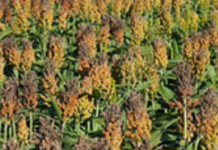Jami Seirer, Northwest District Forester, Kansas Forest Service
Windbreaks are valuable assets to homes, farms, and ranching operations. By reducing effects of harsh Kansas winds, shelterbelts can increase crop yields, improve water use and energy efficiency, control drifting snow, raise calving success rates, and provide habitat and forage for wildlife.
… But wait! There’s more!
Many of the trees and shrubs present in Kansas windbreaks offer harvestable treats that can be used to make fun new recipes to add to your table. If you’re ready to get more out of your windbreak, jump on the edible landscape bandwagon and try these recipes!
Edible Plants in Kansas Windbreaks
The most important prerequisite to cooking with trees and shrubs in your windbreak is accurate plant identification. Do not eat or drink plants that you cannot positively identify and judge to be safe. Also keep in mind that while some parts of a plant are edible, not all structures of the plant are safe to consume. Flowers, leaves, stems, roots, seeds, and other plant structures can contain toxic compounds which may not be safe to eat. Only cook with the portions of the plant which have been cited as safe for human consumption.
Typical plants found in Kansas windbreaks which have edible structures include:
Eastern Red Cedar / Rocky Mountain Juniper
The cones (berries) are used to flavor hot dishes, sauces, and stuffing accompanying game meats and wild fish. Cones and foliage are also used to make medicinal teas and salves but should be ingested sparingly as they act as an intense diuretic which may be hard on the kidneys.
Oaks
Acorns should be boiled and/or roasted to break down tannins. Bur oak acorns are said to be the better tasting of the oak family as the acorns contain fewer tannins.
Mulberry, Hackberry, Persimmon, American/Sandhill Plum, Choke Cherry, Elderberry, Golden Currant
Fruit from these plants can be harvested to make preserves, sorbets, pies, cobblers, sweet breads, syrups, soaps, beverages, puddings, and more!
Cottonwood
Buds of cottonwoods are harvested and used in salves for relieving sore muscles and arthritic pain.
Lilac
Lilac blooms are commonly used to make sugars, syrups, preserves, wines and other beverages, cakes and tarts, edible décor, and fragrances.
Note: if these plants and/or the edible structures of each cannot be positively identified, DO NOT harvest. If the windbreak has been sprayed, or if herbicide drift from neighboring fields is possible, follow the chemical labels for safe harvesting guidelines. For identification help, visit www.kansasforests.org.
Redbud Jelly (produces 3.5 half-pint jars)
3 cups redbud flowers (could substitute with lilac flowers) 
2 cups boiling water
2-3 tablespoons lemon juice
3 tablespoons Sure-Jell powdered pectin
2 cups sugar
1-2 teaspoons butter
-
- Gather three cups of fresh, new redbud blooms.
- Bring two cups of water to boil, then pour over the blooms.
- Stir the mixture, cover, and place in the refrigerator overnight.
- Pour the mixture through a fine strainer (cloth, coffee filter, etc.); save as much liquid as possible.
- Heat the redbud tea to boiling.
- Add lemon juice and Sure-Jell; bring to boil.
- Add sugar and butter; heat to boiling.
- Boil hard for 1 minute, stirring continuously.
- Fill sterilized jars and seal/process properly. Visit www.rrc.k-state.edu/preservation/ for information on proper canning procedures.
Sandhill Plum BBQ Sauce (makes 1 quart)
½ cup shallot or red onion
5 lbs ripe sandhill plums
2 tablespoons of grated fresh ginger
½ cup apple cider vinegar
½ teaspoon kosher salt
½ teaspoon each ground: nutmeg, cloves, cinnamon, allspice
¼ teaspoon ground cardamom
¼ teaspoon cayenne
¾ cup honey or maple syrup
2 tablespoons canola oil
- Preheat the oven to 350. Warm the plums in a pan in the oven until hot throughout, and very soft when touched. Pour the plums and juice into a colander set over a large bowl; allow to drain and cool until you can handle them.
- Mash the plums through the colander with a gloved hand, leaving the pits and skins behind. Keep the pulp, discard the rest.
- In a small sauce pot, sauté the shallots or onion and ginger in the oil until translucent, then add the remaining ingredients including the plum pulp, bring to a simmer and cook for 15 minutes, or until the mixture has thickened nicely.
- Puree the mixture in a blender until smooth. Double check the seasoning and adjust as needed, then refrigerate or can.
Great sauce to add to roasted chicken, game, or pork. Recipe and photo from foragerchef.com.
Acorn Flour
Crack acorns out of their shells and boil them for 2-4 hours, changing the water for fresh boiling water if the water becomes dark. Boiling removes most of the bitter-tasting tannins from the acorns. Taste the acorns periodically to see if the bitterness is gone. Some species of oak, such as bur oak, have much lower tannin levels and won’t need to be boiled as long. Drain the acorns and spread them onto a shallow pan or cookie sheet. Roast them for about an hour at 300°F. Grind acorns into a fine powder using a food processor. Store in airtight container or freeze for extended shelf life.
Savory Oak Muffins (makes 18 muffins)
1 cup cornmeal
1 cup all-purpose flour
3 teaspoons baking powder
1 teaspoon onion or garlic salt
1 egg slightly beaten
1 ½ cups milk
2 tablespoons bacon grease, melted
- Sift together first five ingredients.
- Beat the egg and milk together; stir in bacon drippings.
- Add liquid ingredients to dry ingredients and stir just until moistened; don’t overmix.
- Pour into well-greased muffin tins and bake at 425°F for 15 minutes, or until golden brown.
Recipes for the acorn flour and savory acorn muffins were provided by the North Dakota Forest Service’s “Windbreak Cookbook: Featuring Fruits of Prairie Forests”. For more recipes, visit the cookbook online at
www.ag.ndsu.edu/ndfs/documents/cookbook.pdf. Photo: Bur Oak acorn, Nebraska Forest Service
Windbreak Assistance
A quick Google search can provide endless recipes for jams, jellies, breads, sides, beverages, main dishes, desserts, medicinal teas, and salves- all using ingredients from the trees and shrubs your windbreak. If your windbreak needs a little TLC to restore functionality, or if you’re looking to add edible components to a new windbreak, contact your Kansas Forest Service district forester for design assistance. Visit www.kansasforests.org for more information.
Happy cooking!





